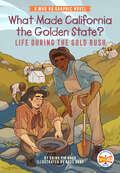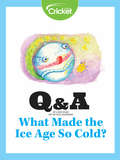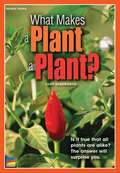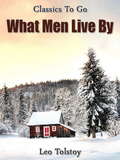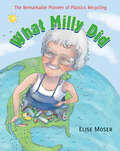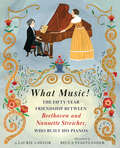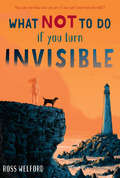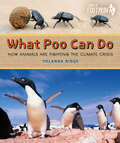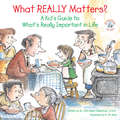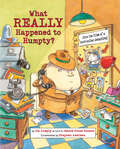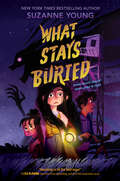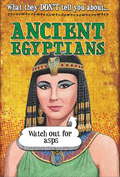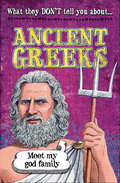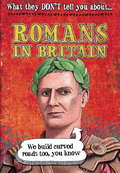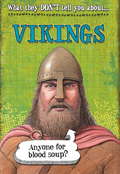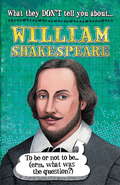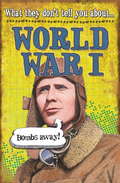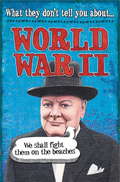- Table View
- List View
What Made California the Golden State?: A Who HQ Graphic Novel (Who HQ Graphic Novels)
by Who HQ Shing Yin KhorDiscover what life was really like during the California Gold Rush in this powerful graphic novel written by National Book Award finalist and Eisner Award-winning creator Shing Yin Khor and illustrated by Kass Gray.Presenting Who HQ Graphic Novels: an exciting addition to the #1 New York Times best-selling Who Was? series!Explore the Gold Rush from the perspective of William Miller and Henry Garrison, two miners in the Sierra Nevada region, and uncover the often unrelenting conditions of the California gold mines. A story of community, determination, and the search for the American Dream, this graphic novel invites readers to immerse themselves into what life was really like during this pivotal period in American history--brought to life by gripping narrative and vivid full-color illustrations that jump off the page.
What Made the Ice Age So Cold?
by Lizzie WadeWhat made the ice age so cold? This Q & A defines the different ice ages of the Earth and when they come about.
What Makes Day and Night
by Franklyn M. Branley"What Makes Day and Night" goes through the cycle of the earth and its revolutions around the sun.
What Makes Living Things Go? (SEEDS Book Reader)
by Jonathan Curley Kevin BealsNIMAC-sourced textbook
What Makes Me Special: A neurodiverse child's journey
by Claudia Rose AddeoThis children’s piece of literature can be read by children ages 4-9, but also welcomes readers of all ages who are among the neurodiverse community. This bright, colorful children’s book reflects the author’s childhood navigating a mainstream education system through the eyes of a neurodiverse learner. A very happy-go-lucky child shares all of the obstacles and gifts that come with being a neurodiverse learner and how that can appear in her everyday life. Whether it entails navigating sensory overload, demonstrating her creative talents, or receiving special education services, Claudia shares all of the unique aspects of her childhood that also relate to so many other children among the neurodiverse community. Though there are certainly times that Claudia can face challenges that appear overwhelming, this sensitive, kind, and optimistic little girl always manages to remind herself that hard work does pay off and understands that these are the qualities that make her special. Claudia reminds readers of all ages the importance of being kind and accepting of one another, as well as being able to recognize the many beautiful gifts neurodiverse learners possess that make them special!
What Makes a Monster?: Discovering the World's Scariest Creatures (The World of Weird Animals)
by Jess KeatingMonsters are real—and they're everywhere in nature! Animal Planet meets Godzilla in this nonfiction picture book that puts the "Ack!" into backyard science. Some people think monsters are the stuff of nightmares—the stuff of scary movies and Halloween. But monsters can also be found right in your backyard. Animals like aye-ayes, goblin sharks and vampire bats may look scary, but they pose no threat to humans. Others, such as the prairie dog, seem innocent—cute, even—yet their behavior could give you goose bumps. What makes a monster? Read this book to find out, if you dare. . . . Jess Keating and David DeGrand, the author illustrator team behind Pink Is for Blobfish will have readers shrieking with laughter at this latest installment to the World of Weird Animals series.
What Makes a Plant a Plant?
by Gary RushworthFind out about what makes a plant an plant and how plants are different from other living things.
What Men Live By: Stories By Tolstoy (Classics To Go)
by Leo TolstoyA kind and humble shoemaker called Simon goes out one day to purchase sheep-skins in order to sew a winter coat for his wife and himself to share. Usually the little money, which Simon earned would be spent to feed his wife and children. Simon decided that in order to afford the skins he must go on a collection to receive the five Rubels and twenty Kopeks owed to him by his customers. As he heads out to collect the money he also borrows a three Rubel note from his wife's money box. While going on his collection he only manages to receive twenty Kopeks rather than the full amount. Feeling disheartened by this Simon rashly spends the twenty Kopeks on Vodka and starts to head back home...
What Milly Did: The Remarkable Pioneer of Plastics Recycling
by Elise MoserThe extraordinary story of the woman who made plastics recycling possible. Milly Zantow wanted to solve the problem of her town’s full landfill and ended up creating a global recycling standard — the system of numbers you see inside the little triangle on plastics. This is the inspiring story of how she mobilized her community, creating sweeping change to help the environment. On a trip to Japan in 1978, Milly noticed that people were putting little bundles out on the street each morning. They were recycling — something that hadn’t taken hold in North America. When she returned to Sauk City, Wisconsin, she discovered that her town’s landfill was nearing capacity, and that plastic made up a large part of the garbage. No one was recycling plastics. Milly decided to figure out how. She discovered that there are more than seven kinds of plastic, and they can’t be combined for recycling, so she learned how to use various tests to identify them. Then she found a company willing to use recycled plastic, but the plastic would have to be ground up first. Milly and her friend bought a huge industrial grinder and established E-Z Recycling. They worked with local school children and their community, and they helped other communities start their own recycling programs. But Milly knew that the large-scale recycling of plastics would never work unless people could easily identify the seven types. She came up with the idea of placing an identifying number in the little recycling triangle, which has become the international standard. Milly's story is a glimpse into the early days of the recycling movement and shows how, thanks to her determination, hard work and community-building, huge changes took place, spreading rapidly across North America. Correlates to the Common Core State Standards in English Language Arts: CCSS.ELA-LITERACY.RI.3.3 Describe the relationship between a series of historical events, scientific ideas or concepts, or steps in technical procedures in a text, using language that pertains to time, sequence, and cause/effect. CCSS.ELA-LITERACY.RI.4.7 Interpret information presented visually, orally, or quantitatively (e.g., in charts, graphs, diagrams, time lines, animations, or interactive elements on Web pages) and explain how the information contributes to an understanding of the text in which it appears.
What Music!: The Fifty-year Friendship between Beethoven and Nannette Streicher, Who Built His Pianos
by Laurie LawlorStrings quivered. Notes shimmered. Meet best friends acclaimed composer Ludwig van Beethoven and bold female entrepreneur Nannette Streicher in this lively and lyrical nonfiction picture book.In a tall, narrow building on a wide avenue pianos plinked and plunked day and night.Everyone in quiet Augsburg knew the Stein home.What music!In 1787, aspiring yet unknown composer Ludwig van Beethoven arrives at young Nannette Stein&’s home. What follows is a decades-long friendship that persists whether life hits a low or high note. Acclaimed nonfiction writer Laurie Lawlor deftly depicts how these two fascinating friends—a composer with hearing loss and a woman who became an innovative piano maker in a time that discouraged female entrepreneurship—fought the odds and worked together in perfect harmony. The author of picture book biography Fearless World Traveler, Lawlor masterfully uses forgotten historical letters, a glossary, and rich back matter on both friends&’ lives and art to introduce readers to the man behind the music, from his loud laughter to his crushing handshake. Complete with Fearless World Traveler collaborator Becca Stadtlander&’s intricate mixed-media artwork, What Music deftly dives into musical history–and herstory–in an intimate yet expansive picture book biography that hits just the right note.
What Not to Do If You Turn Invisible
by Ross WelfordA surprising, stunningly beautiful, and funny novel about a girl who turns invisible and, in the process, discovers who she really is, from the author of TIME TRAVELING WITH A HAMSTER Twelve-year-old Ethel Leatherhead only meant to cure her acne, not turn herself invisible. But that's exactly what happens when she combines herbs bought on the Internet with time spent in a secondhand tanning bed. At first it's terrifying to be invisible . . . and then it's fun . . . but when the effect doesn't wear off one day, Ethel is thrown into a heart-stopping adventure. With her friend Boydy by her side, Ethel struggles to conceal her invisibility, all the while unraveling the biggest secret of all: who she really is. From the talented author of Time Traveling with a Hamster comes another utterly original, deeply poignant--and humorous--novel about a girl who, by disappearing, will write herself into your heart forever.
What Poo Can Do: How Animals Are Fighting the Climate Crisis (Orca Footprints #29)
by Yolanda RidgeWe all know animals are affected by the climate crisis. But did you know the climate crisis is also affected by animals? From whales to dung beetles, What Poo Can Do explores how animals big and small are helping the planet every time they do a number two. Come on a journey to different parts of the world to see how animals are fertilizing plants, storing carbon, preventing fires, reducing methane and even creating color-coded maps—all through their feces! Readers will discover how animal defecation makes a difference when it comes to the climate crisis. It's time to embrace the power of poo! The epub edition of this title is fully accessible.
What REALLY Matters?
by R. W. Alley Brother John Mark FalkenhainOne of the most important gifts we can offer a child is passing along to them the values that will help them form their own sense of what is important--a sense of what REALLY matters. In What Really Matters? A Kid's Guide to What's Really Important in Life, author John Mark Falkenhain, O.S.B., helps both children and adults reflect on those things in life which are most important, especially respect, relationships, and love.
What Really Happened to Humpty?: From The Files Of A Hard-boiled Detective (Nursery-Rhyme Mysteries)
by Jeanie Franz RansomA scrambled mess . . .Humpty Dumpty had a great fall. Or--as his brother Detective Joe Dumpty thinks--was he pushed? This case isn't all it's cracked up to be. Suspects are plenty (as are the puns) in this scrambled story of nursery rhyme noir. Was it Little Miss Muffet? There's something not right about her tuffet. Or could it have been Chicken Little, who's always been a little cagey? Or was it the Big Bad Wolf, who's got a rap sheet as long as a moonless night? Joe's on the beat and determined to find the truth.Readers of all ages will delight in the word play and hilarious illustrations in this mystery of what really happened to Humpty Dumpty on that fateful day.
What Stays Buried
by Suzanne YoungIn her first book for middle grade readers, New York Times bestselling author Suzanne Young brings together a thrilling ghost story, a heartfelt coming of age journey, and a poignant reminder that those we’ve loved and lost are never far away—perfect for fans of Bone Hollow and The Peculiar Incident on Shady Street.Twelve-year-old Calista Wynn will lose her ability to speak with the dead on her thirteenth birthday. And with only a few weeks left, children have started going missing.When Calista meets The Tall Lady—an angry spirit with a grudge against Calista, her family, and the entire town—she knows she’s found the ghost responsible for the disappearances.It’s up to Calista, the only one who can see The Tall Lady, to stop her. If she doesn’t, Calista won’t just lose her powers… she’ll lose everyone she has left.
What The Animals Do and Say
by Eliza Lee FollenA charming piece of juvenile fiction, this work is informative as well as interesting. The engrossing narrative not only teaches children about wildlife but also conveys enduring moral lessons. With colourful imagery and captivating events revolving around the lives of various animals and birds, this is an astounding work.
What The Moon Is Like
by True Kelley Franklyn M. BranleyImagine that you're walking on the moon. What is it like? For thousands of years people looked up at the moon and wondered about it. Now we know what the moon is like. There is no air on the moon and nothing grows, but there are towering mountains and deep craters--and much more! Colder than the desert, the hotter than the desert, the moon is an amazing place to explore.
What They Don't Tell You About: Ancient Egyptians
by David JayDid you know that Egyptian policemen used monkeys to arrest people? The Ancient Egyptians lived half of their lives up to their eyes in mud, the other half choking on desert sand, and spent most of their time thinking about dying! Any history book will give you the boring facts THEY think you should know, but only this one will tell you just how weird life in Ancient Egypt REALLY was ...
What They Don't Tell You About: Ancient Greeks
by Robert FowkeDid you know that Greek athletes used to win olive oil as prizes? From hunky heroes to funky philosophers, the Ancient Greeks have had a gigantic influence on life as we know it! Any history book will give you the boring facts THEY think you should know, but only this will dish the real dirt on those Ancient Greek culture vultures.
What They Don't Tell You About: Romans In Britain
by Robert FowkeDid you know that some Roman generals would execute their own sons if they were disobedient? They had gory gladiators and evil emperors, they threw up at banquets and worshipped strange gods - but what else did the Romans do when they invaded Britain? Any history book will give you the boring facts THEY think you should know, but only this one will tell you what the Romans were REALLY like ...
What They Don't Tell You About: Vikings
by Robert FowkeDid you know that Vikings liked to slurp blood soup for supper? Highly-practised in the art of thuggery, the Vikings loved their drink, sacrificed humans in the name of religion and didn't bother with school! Any history book will give you the boring facts THEY think you should know, but only this one will tell you what the blood-thirsty Vikings were REALLY like ...
What They Don't Tell You About: William Shakespeare
by Anita GaneriDid you know that Shakespeare couldn't spell his own surname? Love him or hate him, everyone has heard of the world's most famous playwright. But did the Elizabethans think he was a genius or simply that he wrote great soap operas? Any book on Shakespeare will give you the boring facts THEY think you should know, but only this one will tell you what the bard and his mates were REALLY like ... Uncover a wealth of information about Shakespeare! Find out where he was born and look at his family tree, see a map of Shakespeare's Stratford and Shakespeare's London, find out what school was like in Shakespeare's time, what London life was like and what sort of people went to the theatre. See a cross-section illustration of the Globe and discover how special effects were created and what actors wore. Read biographies of famous actors of the era such as Edward Alleyn, Richard Burbage, Richard Tarlton and William Kempe as well as biographies of contemporary writers Ben Jonson, Thomas Kyd and Christopher Marlowe. Read famous quotes and sayings and whizz your eye over a timeline of Shakespeare's plays and of his life. This book will tell you what Shakespeare's longest or shortest play is, or even which is the most miserable or goriest? It includes plots and information about ten of Shakespeare's plays: Richard III; Romeo and Juliet; A Midsummer Night's Dream; The Merchant of Venice; Henry V; Twelfth Night; Hamlet; Othello; Macbeth and The Tempest. It highlights some of Shakespeare's funniest characters and some of those that were in love. It concludes looking at how Shakespeare died, and discusses whether Shakespeare was, in fact, Sir Francis Bacon, Edward De Vere, Roger Manners, William Stanley or Christopher Marlowe. Finally, test your knowledge of all you've read with a fun 20-question quiz.
What They Don't Tell You About: World War I
by Robert FowkeThis book explains how the war started, what it was about and who it involved. It describes the major battles and looks at what life was like for the soldiers in the trenches, the pilots in the air, the sailors at sea and the civilians back home. Written in the lively style common to this series, the author deals with this difficult subject in a sensitive and skilful manner, introducing humour only where appropriate. With black line illustrations throughout.
What They Don't Tell You About: World War II
by Robert FowkeDid you know that Adolf Hilter wasn't, in fact, German? The Second World War brought horror and heartache to millions of people all over the globe, and it turned everyday living upside down too. Any history book will give you the boring facts THEY think you should know, but only this one will tell you what life during World War II was REALLY like ...
